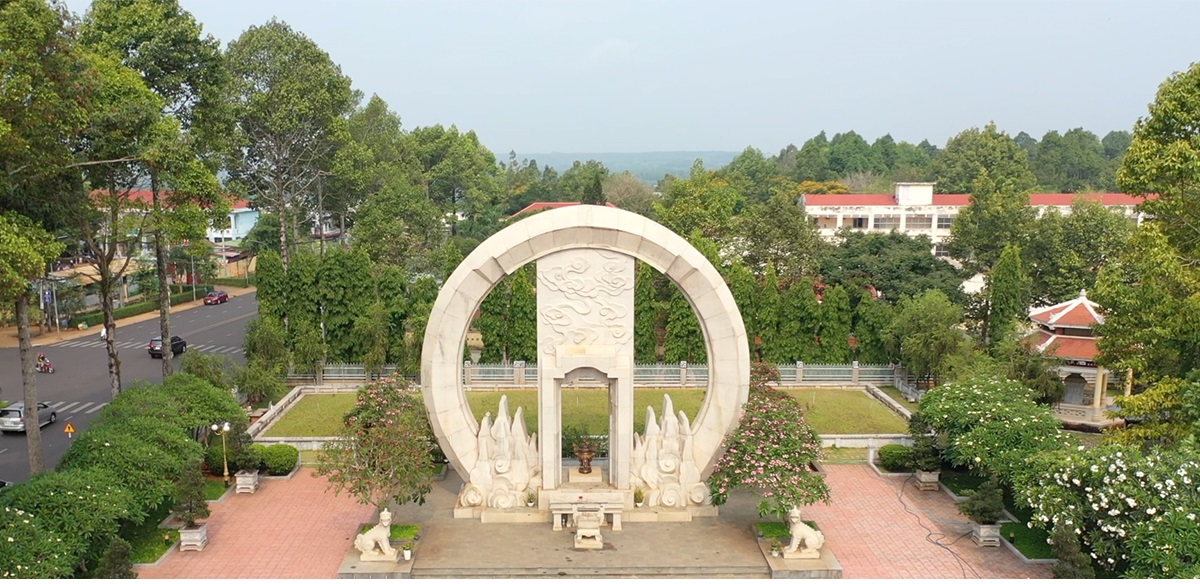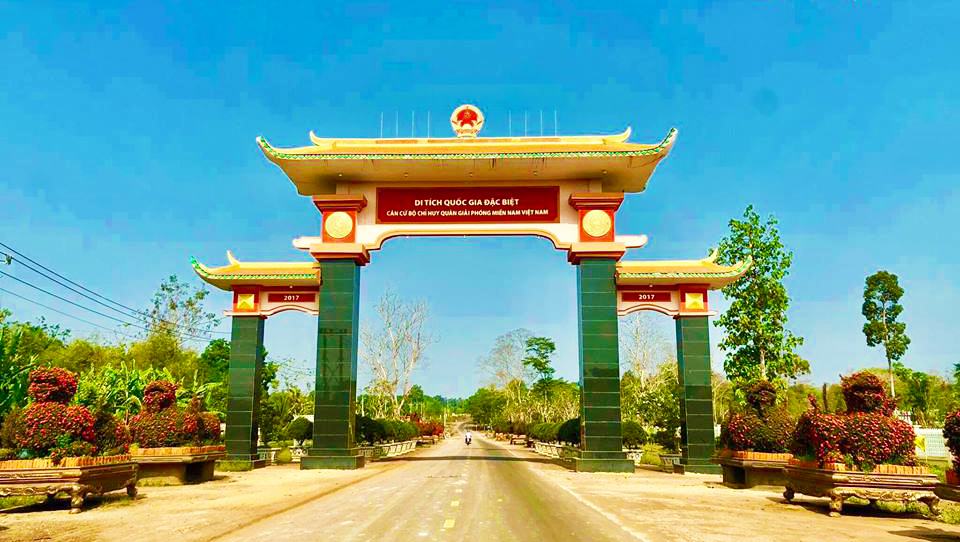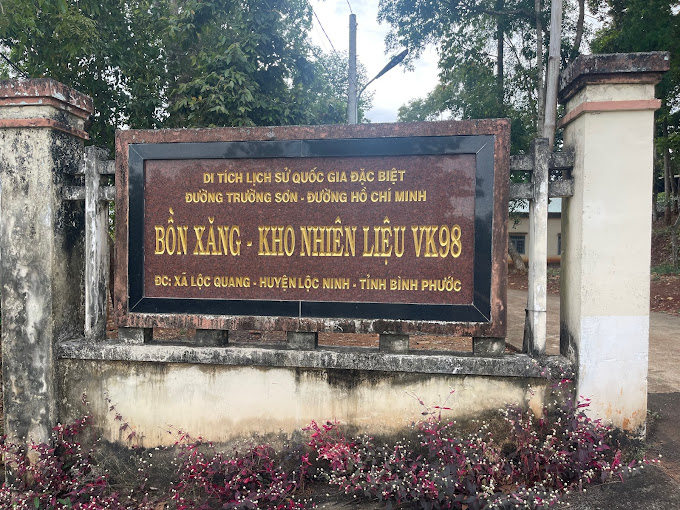Relic point Vietnam
Việt NamGrave of 3,000 An Loc compatriots massacred by the US imperialists on October 3, 1972
The relic of the grave of 3,000 An Loc compatriots who were massacred by the US imperialists on October 3, 1972 (also known as the collective grave of 3,000 people) is located in An Loc ward, Binh Long town, Binh Phuoc province, and is one of the Evidence marks the war crimes that the US and puppets committed against our people in general and the people of Binh Long in particular during the resistance war against the US. In 1971, implementing the policy of the Politburo, the Central Executive Committee of the Communist Party of Vietnam met and approved the determination to defeat the "Vietnamization of the war" strategy of the US imperialists and their henchmen, the Nguyen Hue Campaign. was opened with the main attack direction on Road 13 and the decisive battle area of Loc Ninh and An Loc in Binh Long province. On April 7, 1972, Loc Ninh was completely liberated, our troops continued to attack to liberate An Loc town. Faced with the stormy attack of the main force, the enemy tried their best to hold the town because if An Loc was lost, Binh Long would be lost and "Binh Long is gone, Saigon is gone". During 32 days and nights (from April 13 to May 15, 1972), the fighting took place extremely fiercely, the enemy concentrated a large amount of firepower, artillery, bullets, and bombs to plow the ground, thousands of compatriots. murdered, property and houses were heavily destroyed. The enemy also cruelly let a B52 plane drop bombs on An Loc town hospital, where most people gathered to avoid artillery fire and where injured enemy soldiers were being treated, causing many deaths. . To deal with the number of casualties, the enemy used vans and bulldozers to collect and bulldoze thousands of corpses into burial pits, creating a mass grave of over 3,000 people and erecting a stele "Fatherland's credit" to commemorate the deaths. deceive the people. Today, the relics of the graves of 3,000 An Loc compatriots who were massacred by the US imperialists on October 3, 1972 have been invested in and renovated, including the following works: Memorial, Memorial Stele House, Reception House... The relic is A place to commemorate the sacrifices and losses of the Regional Main Army and the people of Binh Long during the resistance war against the US. It is a place for people and tourists to commemorate and learn about the historical traditions of the revolutionary struggle. heroic and glorious of the soldiers and people of Binh Long town. On April 1, 1985, the site of the graves of 3,000 An Loc compatriots who were massacred by the US imperialists on October 3, 1972, was decided by the Minister of Culture to be classified as a national historical relic. Source: Binh Phuoc Provincial Museum Electronic Information Page
Dong Nai 3531 view
Base of the Command of the Liberation Army of South Vietnam
The South Vietnam Liberation Army Command Base Relic is located in Loc Thanh commune, Loc Ninh district, Binh Phuoc province. This place was formerly the Forward Command Post of the Nguyen Hue campaign in 1972. On April 7, 1972, Loc Ninh was liberated, then became the capital of the Provisional Revolutionary Government of the Republic of South Vietnam. . To accommodate the new situation beneficial to the Southern revolution, the Central Bureau and the Regional Command decided to move the Regional Military Commission base from Soc Con Trang (Tay Ninh) to Ta Thiet Soc. The South Vietnam Liberation Army Command base was built in 1973 in the Ta Thiet forest, so it is also called "Government Forest" or Ta Thiet Base. Here, under the canopy of large trees and tangled bamboo forests, is where high-ranking leaders of the Party and State once lived, fought and directly directed the struggle to liberate the South. : Commander Tran Van Tra, Deputy Commander Nguyen Thi Dinh, Political Commissar Pham Hung, Deputy Commander and Chief of Staff Le Duc Anh... Particularly, Senior General Tran Van Tra's house and workplace are built according to stilt house architecture. in an empty glade in the squirrel area of the Khmer ethnic people. In addition, at the Base there is also a system of other service works such as Hoang Cam kitchen, briefing tunnel, conference hall... All are built in a semi-submersible style (half submerged, half above ground) to limit light. The lights go out at night, ensuring safety if the enemy bombs. The materials used are mainly forest trees, the roof is thatched, and each building has a system of escape trenches and shelters. The command bunkers, information bunkers, military medical bunkers... were built quite large, for convenient work as well as precautions when the ground is unsafe. The South Vietnam Liberation Army Command base in Ta Thiet fulfilled its mission of protecting and developing the activities of the Military Commission and the Regional Command in the final phase of the resistance war against the US. Important events took place here: A place to welcome high-ranking delegations from the Politburo, the General Staff, and the Central Bureau to discuss plans to build the armed forces, and a place to implement plans. operations, Directives and Resolutions of the Central Government. In particular, in 1975, here, the Ho Chi Minh Campaign Command was established, making an important contribution to the glorious victory of the historic Ho Chi Minh Campaign, completely liberating the South and reunifying the land. water. In 1994 - 1995, the relics of the South Vietnam Liberation Army Command Base were restored, embellished and brought into play to promote their value. By 2018, the Provincial Party Committee and People's Committee of Binh Phuoc province will carry out a project to renovate, embellish and add items such as: Memorial House, Reception House, Traditional House, Memorial, Gate to the relic site, Landscape lake… Ta Thiet Base Relic is a place marking the activities of the South Vietnam Liberation Army Command in the resistance war against the US for national liberation and national reunification. Today, the relic is both a red address with a meaning of gratitude and education for revolutionary traditions, as well as an ideal tourist destination for tourists. With great historical significance, November 16, 1988 , the Minister of Culture decided to classify the relic of the Command of the Liberation Army of South Vietnam as a national historical relic. On December 23, 2015, the monument was decided by the Prime Minister to rank as a special national historical relic. Source: Binh Phuoc Provincial Museum Electronic Information Page
Dong Nai 4372 view
VK98 fuel storage tank
VK98 Gasoline Tank Relic - Fuel Warehouse is located in Loc Quang commune, Loc Ninh district, Binh Phuoc province. The relic belongs to the special national historical relic system of Truong Son - Ho Chi Minh Trail. The VK98 fuel depot was built in 1974, located around hill 117 (the name of a high point in the military map) in Loc Quang commune, Loc Ninh district, with an area of 10 hectares, including 7 tanks, each tank has the capacity containing 250,000 liters, VK98 total fuel warehouse has a reserve of 1,750,000 liters. The petroleum tanks are welded with steel, each 10m in diameter, 3.5m high and 100m apart in a triangular shape, buried underground, surrounded by forest trees with dense piles. . The tanks are connected to each other by pipelines, at a height above the road surface, so vehicles coming to get gas do not have to use a vacuum cleaner but only need to open the valve to let the material flow into the tank. A company of 30 tank trucks (tank trucks), day and night, transported gasoline and oil from VK96 Bu Gia Map station to gather at the VK98 fuel depot and transport gasoline and oil to the battlefield. After the country's liberation, the petroleum tanks were dismantled by Military Region 7 Logistics, leaving one tank remaining to serve the sightseeing and learning needs of the people. Along with other petroleum gathering points, the VK98 Gas Tank - Fuel Warehouse relic marked a time of "Cutting along Truong Son to save the country", successfully completing the task of supplying petroleum, contributing to the victory. of the historic Ho Chi Minh Campaign, completely liberating the South and reunifying the country. Today, the relic has become one of the places to learn and research about the petroleum pipeline system in particular and the legendary Truong Son road in general during the resistance war against the US. With typical historical values, the Minister of Culture decided to classify the VK98 Gas Tank - Fuel Warehouse relic as a national historical relic on April 21, 1989. On December 9, 2013, the VK98 Gas Tank - Fuel Warehouse relic in Loc Quang commune, Loc Ninh district, Binh Phuoc province is a relic in the Truong Son Road - Ho Chi Minh Road relic system that was approved by the Prime Minister. vetoed the decision to rank a special national historical relic. Source: Binh Phuoc Provincial Museum Electronic Information Page
Dong Nai 4105 view
End point of petroleum pipeline VK96
Ho Chi Minh Road - a bridge connecting the great northern rear with the great southern front line, was a solid base of the southern Indochina battlefield in the resistance war against America. As we know, during the resistance war against the US, petroleum fuel was an urgent requirement to serve the large-scale and speedy war. Binh Phuoc, the land of "the hard-working but heroic East", is very honored and proud when in the province there are two relics belonging to the special relic system of Truong Son - Ho Chi Minh trail, the relics of Petrol Tank - VK98 fuel depot and VK96 petroleum pipeline terminus. Through extremely arduous years, despite terrain conditions, harsh weather and fierce enemy attacks, after 6 years (from 1968 to 1974), Truong Son pipeline soldiers has built, protected and operated smoothly a 5,000km long petroleum pipeline and a petroleum storage system of nearly 30,000 tons from the northern border of the country across Truong Son to Bu Gia Map. Bu Gia Map is the final point of the North-South petroleum pipeline. From here, the petroleum source is transported by tanker truck (completely secret) to the gasoline tanks - VK98 and VK99 fuel warehouses in Loc Ninh. The VK96 petroleum pipeline end point relic also has other names such as: symbols K22, O30. Later, he used the codename VK. The end point of this petroleum pipeline system is VK96, followed by the gasoline tanks in Loc Ninh are VK98 (Loc Quang), VK99 (Loc Hoa). The relic is the place that marks the great and silent victories of the soldiers, petrol soldiers, youth shock troops, local soldiers and civilians... during the years of resistance against the US to save the country of our nation. is a testament to one of the legends of the historic Truong Son road, which is the Truong Son petroleum pipeline system, one of the miracles of Group 559. This is one of the three main systems of the road. undermine Ho Chi Minh's strategy, demonstrating the tenacious spirit and iron will of our army and people in the resistance war against America to save the country. The victory of the resistance war against America to save the country is the victory of Vietnamese revolutionary heroism. In particular, the petroleum pipeline system - Truong Son road is the embodiment of iron will, expressing the will to win, courage, desire for independence, determination to liberate the South, and recover the mountains and rivers. about a bond of the entire Party, entire army and entire people, a shining symbol of the faithful fighting solidarity between the three countries of Vietnam - Laos - Cambodia. Truong Son route has existed in the history of the resistance war against the US to save the country as a legend with the name "Ho Chi Minh Trail". The system of petroleum pipelines - Truong Son road, the road connecting South - North associated with many heroic victories of the entire nation during the years of resistance war is forever a source of great pride, encouragement and encouragement. members of our entire army and people in the work of building and protecting our Fatherland today. With such great historical significance, the VK98 Gasoline Tank - Fuel Warehouse relic in Loc Ninh district and the VK96 petroleum pipeline end point relic in Bu Gia Map district, Binh Phuoc province are located in the Truong Son - Binh Phuoc province relic system. Ho Chi Minh Trail was recognized by the Prime Minister as a special national monument on December 9, 2013. Source: Binh Phuoc Province Electronic Information Portal
Dong Nai 3693 view





